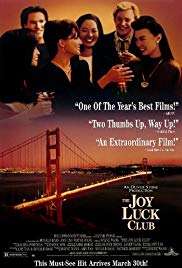This movie is based on the bestseller written by Amy Tan describing the experiences of four women who emigrated from China to the United States. Each woman’s story contains horrendous experiences in China and shows how those experiences affected their relationships with their American born daughters.
Selected Awards: None.
Featured Actors: Tsai Chin, Qieu Chinh, France Nuyen, Rosalind Chow, Tamlyn Tomita, Lisa Lu, Lauren Tom, Ming Na-Wen, Michael Paul Chan, Andrew McCarthy, Christopher Rich, Russell Wong, Victor Wong, III.
Director: Wayne Wang.
“The Joy Luck Club” shows us something about the culture and history of China in the early 20th century, focusing on the mistreatment of women. It also explores the relationships that Asian-American women have with their mothers and relationships between girls and their mothers generally.
SERIOUS. In one sequence, a male baby is drowned by his mother in warm bath water. The mother has been physically and psychologically abused by her husband, the baby’s father. She is trying to get back at him by killing his son. This sequence shows no graphic violence to the child but it is extremely powerful and disturbing. In another scene, a mother, thinking that she was going to die, abandons her twin children by the roadside in the hope that someone would find them and care for them.
The novel from which this film has been adapted is often read by high school students and the film should not be used as a substitute for the book. Should your child see the film without reading the book, you may suggest that he or she read the book. If you have both seen the movie and read the book, you may want to engage in a discussion of the differences. Ask and help your child to answer the Quick Discussion Question.
Infanticide (the killing of a child) has been practiced by many cultures. The Greeks, Romans and Hawaiians destroyed deformed infants. The murder of female children was a common practice in China for hundreds of years. Most infanticides are the result of a chronic and severe shortage of food or disappointment at having a female child. What was significant about the infanticide shown in this movie was that the victim was male. The mother was trying to get back at her husband.
China was ruled from 1644 – 1911 by the Quing (also called Manchu) Dynasty. In the 1800s and early 1900s, China was in decline, wracked by civil war and under pressure from the West and the Japanese. The Western powers (Britain, France and the United States) forced China to grant them trading concessions and privileged status. The British controlled the opium trade. Seeking a way to pay for the huge amounts of tea that they imported from China, the British sought to sell opium in China. Large numbers of Chinese became addicted to the drug. With opium addiction growing, the Manchus seized and destroyed opium owned by the British resulting in the Opium War of 1839 – 1843. The Chinese lost the war and were forced to open China to the opium trade, pay reparations, open ports to British trade, cede Hong Kong and give British citizens in China the right to be tried in British Courts. There was another war over trading rights in 1856 – 1860.
In addition to these wars, there were several rebellions, the most remarkable of which was a popular revolt against the Manchu Dynasty called the Taiping Rebellion (1850 – 1864) which resulted in the deaths of 20 – 30 million people. Although eventually crushed, the Taiping Rebellion seriously weakened the Manchu Dynasty.
In 1911 uprisings against the Manchu Dynasty led by Sun Yat-sen occurred throughout the country. A national government was established but it was internally divided and had little power. In 1915 the Japanese sought to make China a virtual province with the Twenty-One Demands. China was forced to agree to many of these and sought help from the West by belatedly entering World War I on the Allied side. Sold out at Versailles by the U.S. in return for Japan’s agreement not to press for a racial equality clause in the charter of the League of Nations, China was then subjected to civil war between the Koumintang (led by Chiang Kai-shek) and the Communists (lead by Mao Zedong) until a truce was called so that the Chinese could unite to resist Japanese aggression in WWII.
MOTHER/DAUGHTER
1. Which of the Mother/Daughter combinations had the best relationship? Which had the worst?
SURVIVING
2. Which of the mothers had the most horrendous experience while she was in China?
3. Why did the mother of the twin girls leave them by the roadside to die?
Discussion Questions Relating to Ethical Issues will facilitate the use of this film to teach ethical principles and critical viewing. Additional questions are set out below.
CARING
(Be kind; Be compassionate and show you care; Express gratitude; Forgive others; Help people in need)
1. What saved the personalities of these women through all the hard times that they endured?
Books recommended for middle school and junior high readers include Extraordinary Asian-Pacific Americans by Susan Sinott and Child of the Owl, by Laurence Yep. Adult books recommended as suitable for better adolescent readers relating to the experiences of Chinese Americans include Gates of Grace by Evelina Chao (about a girl), Dragonwings by Lawrence Yep (about a boy), Second Daughter by Katherine Wei and, of course, The Joy Luck Club by Amy Tan.
This Learning Guide was last updated on August 11, 2010.


